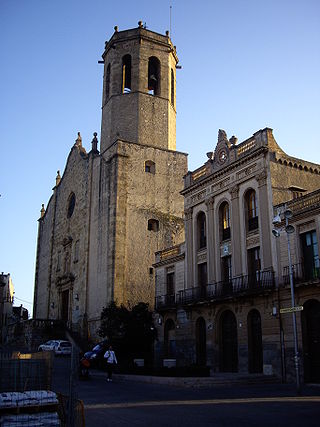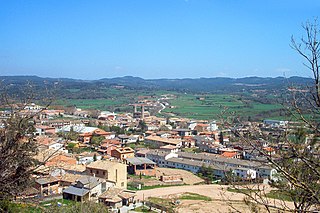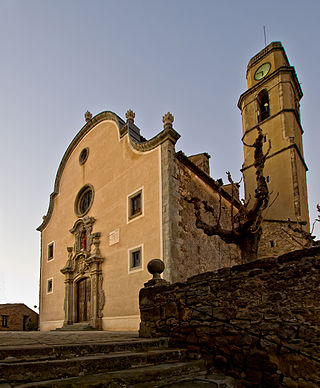Related Research Articles

Mollerussa is the capital of the comarca of Pla d'Urgell, in the province of Lleida, Catalonia, Spain. It is 250 metres above sea level. In 2010 it had a population of 14,733.

Sant Boi de Llobregat is a city in the Province of Barcelona in Catalonia, Spain, located on the banks of the Llobregat river. In 2019 it had 83,605 inhabitants.

Viladecans is a town near Barcelona, Spain. It is located between Sant Boi de Llobregat and Sant Climent de Llobregat, and is on the coast of the Mediterranean Sea between El Prat de Llobregat and Gavà. It has a hospital, which serves the surrounding towns.

Olost is a municipality in the province of Barcelona, Catalonia, Spain. It has less than 1,200 people, situated on a plain 669 meters above sea level at 20 km from Vic in the center of the ancient shire or comarca of Lluçanès, before in the comarca of Osona. In the center of the village stands the church of Santa Maria d'Olost of monumental size, with a large façade and two bell towers. Its construction started in the 10th century and ended in the 18th century. Near Olost are the two small settlements of Santa Creu de Jutglars and the Vila with Sant Gil de la Vila and the unusual Castell d'Olost, built in 1155 with added elements of the 14th and 15th centuries, that lies in a depression next to a stream in the district of Orista. Even though it was a fortified farm, it has the structure of a castle; it is nearly hidden from view for protection in the Middle Ages.

Vilanova i la Geltrú is the capital city of Garraf comarca, in the province of Barcelona, Catalonia, Spain. Historically, it is the result of the aggregation of the medieval center of La Geltrú with the center built outside the medieval walls, Vilanova. Initially, the lands of Vilanova belonged to Cubelles, the neighboring town. The city of Vilanova i la Geltrú has a growing population of approximately 66,000, and is situated 40 km south-west of Barcelona, with the coastal resort of Sitges some 10 km to the north-east.

Alpens is a municipality situated in the comarca of Lluçanès, in the province of Barcelona, Catalonia, Spain. Alpens is located 105 km from the city of Barcelona and 13 km from the comarca capital, Prats de Lluçanès.

Sant Quirze de Besora is a municipality in the comarca of Osona in Catalonia, Spain. It is situated on the banks of the Ter river in the north of the comarca. It is on the main communication route between Barcelona and Puigcerdà, served by the C-17 road and a station on the RENFE railway line. It is also linked to Prats de Lluçanès and the Berguedà by the C-149 road. There is a tradition of textile manufacture in the town, as well as a distillery and a hydroelectric power station.

Prats de Lluçanès is a municipality in the comarca of Lluçanès in Catalonia, Spain. It is situated in the west of the comarca, on a plain between the Lluçanès and Merlès rivers, and is served by the C-154 road between Vic and Gironella.

Lluçanès is a comarca of Catalonia, in the central region, transitioning between the Plain of Vic and Berguedà, in the pre-Pyrenees. It was established as an official comarca in May 2023. The capital is the town of Prats de Lluçanès.

Lluçà is a municipality in the comarca of Lluçanès in Catalonia, Spain. It is subdivided into the town of Santa Eulàlia de Puigoriol, and the much smaller village of Lluçà. This village, prominent because of its monastery, gives its name to the surrounding natural comarca of Lluçanès.

Oristà is a municipality in the comarca of Lluçanès in Catalonia, Spain. It includes an exclave within Sant Feliu Sasserra.

Sant Agustí de Lluçanès is a municipality in the comarca of Osona in Catalonia, Spain.

Sant Bartomeu del Grau is a municipality in the comarca of Osona in Catalonia, Spain.

Sant Boi de Lluçanès is a municipality in the comarca of Osona in Catalonia, Spain.

Sant Martí d'Albars is a municipality in the comarca of Lluçanès in Catalonia, Spain.

Sant Feliu Sasserra is a municipality in the extreme north-east of the comarca of Bages, in Catalonia. It is also within the natural comarca of Lluçanès.

Prats i Sansor is a municipality in the comarca of Cerdanya, province of Lleida, Catalonia, Spain. It is composed by four villages, Prats, Sansor, Capdevila and El Pla.

Sant Climent de Llobregat is a municipality in the comarca of Baix Llobregat, Barcelona Province, Catalonia, Spain. It is connected by road with Viladecans and Sant Boi de Llobregat.

Monestir de Sant Feliu de Guíxols is a Benedictine monastery in Sant Feliu de Guíxols, in the comarca of the Baix Empordà in Catalonia, Spain. It was first referenced around the year 961, and was declared a Bien de Interés Cultural landmark in 1931.
Witch trials took place in the Principality of Catalonia in Spain between the 14th-century and 1767. Witch trials were comparably uncommon in Spain, and most of them took place in Catalonia and Navarre. While witch trials were uncommon in the rest of Spain, the witch trials in Catalonia had similarities with the witch trials in the rest of Western Europe, and are therefore a separate chapter in the context of witch trials in Spain. Around 400 women were prosecuted for witchcraft in Catalonia.
References
- ↑ "Per bruixa i metzinera": la cacera de bruixes a Catalunya : Museu d'Historia de Catalunya, 25 de gener-27 de maig de 2007. Generalitat de Catalunya, Departament de Cultura i Mitjans de Communicacio, 2007
- ↑ "Tourist tour of the Napa Witch in Prats de Lluçanès | COOLTUR Turisme Cultural". 2022-05-01. Retrieved 2022-09-01.
- ↑ Sparks, Tori (2021-11-30). "They Were Not Witches, They Were Women". (barcelona-metropolitan.com). Retrieved 2022-09-01.
- ↑ AADD, El Lluçanès màgic. Recull de llegendes i rondalles del Lluçanès, Edicions Cossetània i Ajuntament de Sant Boi de Lluçanès, 1998.
- AADD, El Lluçanès màgic. Recull de llegendes i rondalles del Lluçanès, Edicions Cossetània i Ajuntament de Sant Boi de Lluçanès, 1998.
- GORCHS, A., Prats de Lluçanès, 905-2005. Cronologia de 1.100 anys d'història, Ajuntament de Prats de Lluçanès, 2006.